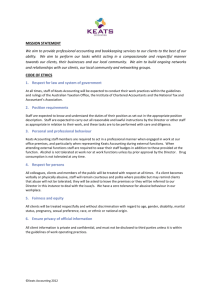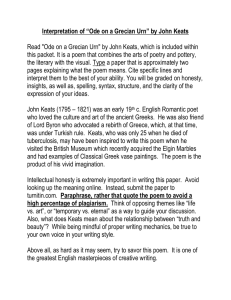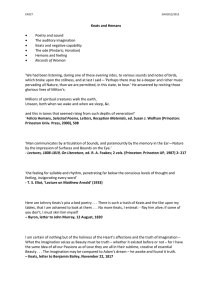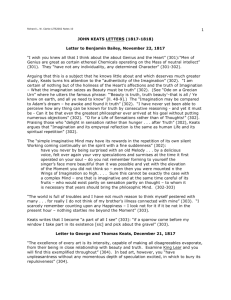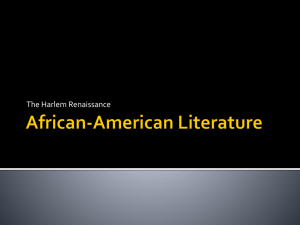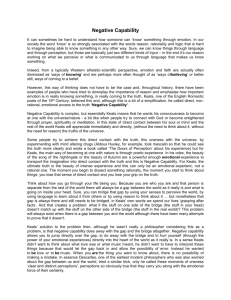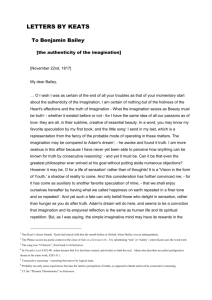Keats and the Psychobiological Formulations of Negative Capability
advertisement
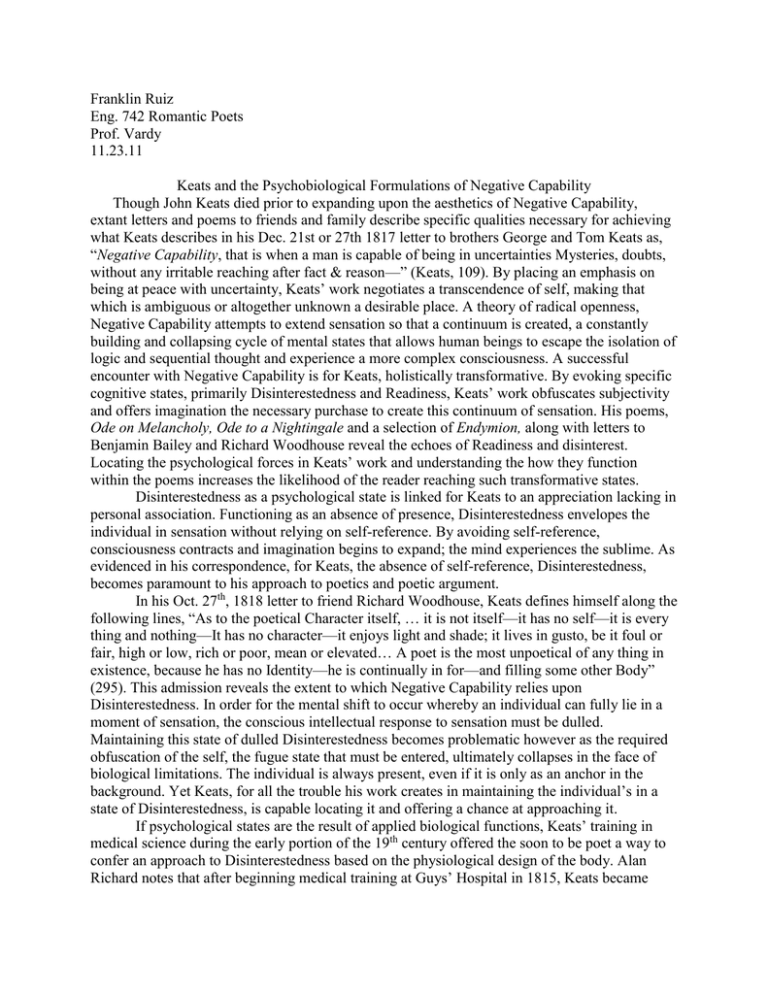
Franklin Ruiz Eng. 742 Romantic Poets Prof. Vardy 11.23.11 Keats and the Psychobiological Formulations of Negative Capability Though John Keats died prior to expanding upon the aesthetics of Negative Capability, extant letters and poems to friends and family describe specific qualities necessary for achieving what Keats describes in his Dec. 21st or 27th 1817 letter to brothers George and Tom Keats as, “Negative Capability, that is when a man is capable of being in uncertainties Mysteries, doubts, without any irritable reaching after fact & reason—” (Keats, 109). By placing an emphasis on being at peace with uncertainty, Keats’ work negotiates a transcendence of self, making that which is ambiguous or altogether unknown a desirable place. A theory of radical openness, Negative Capability attempts to extend sensation so that a continuum is created, a constantly building and collapsing cycle of mental states that allows human beings to escape the isolation of logic and sequential thought and experience a more complex consciousness. A successful encounter with Negative Capability is for Keats, holistically transformative. By evoking specific cognitive states, primarily Disinterestedness and Readiness, Keats’ work obfuscates subjectivity and offers imagination the necessary purchase to create this continuum of sensation. His poems, Ode on Melancholy, Ode to a Nightingale and a selection of Endymion, along with letters to Benjamin Bailey and Richard Woodhouse reveal the echoes of Readiness and disinterest. Locating the psychological forces in Keats’ work and understanding the how they function within the poems increases the likelihood of the reader reaching such transformative states. Disinterestedness as a psychological state is linked for Keats to an appreciation lacking in personal association. Functioning as an absence of presence, Disinterestedness envelopes the individual in sensation without relying on self-reference. By avoiding self-reference, consciousness contracts and imagination begins to expand; the mind experiences the sublime. As evidenced in his correspondence, for Keats, the absence of self-reference, Disinterestedness, becomes paramount to his approach to poetics and poetic argument. In his Oct. 27th, 1818 letter to friend Richard Woodhouse, Keats defines himself along the following lines, “As to the poetical Character itself, … it is not itself—it has no self—it is every thing and nothing—It has no character—it enjoys light and shade; it lives in gusto, be it foul or fair, high or low, rich or poor, mean or elevated… A poet is the most unpoetical of any thing in existence, because he has no Identity—he is continually in for—and filling some other Body” (295). This admission reveals the extent to which Negative Capability relies upon Disinterestedness. In order for the mental shift to occur whereby an individual can fully lie in a moment of sensation, the conscious intellectual response to sensation must be dulled. Maintaining this state of dulled Disinterestedness becomes problematic however as the required obfuscation of the self, the fugue state that must be entered, ultimately collapses in the face of biological limitations. The individual is always present, even if it is only as an anchor in the background. Yet Keats, for all the trouble his work creates in maintaining the individual’s in a state of Disinterestedness, is capable locating it and offering a chance at approaching it. If psychological states are the result of applied biological functions, Keats’ training in medical science during the early portion of the 19th century offered the soon to be poet a way to confer an approach to Disinterestedness based on the physiological design of the body. Alan Richard notes that after beginning medical training at Guys’ Hospital in 1815, Keats became 2 intimately aware of the various processes associated with sensation via dissection and anatomy lessons, “ ‘The different sensations,’ Keats reports, ‘reside in peculiar structures as the toes & fingers which have papillac through which the sense of feeling – the papillac of the Tongue are different from those of the Toes & fingers & are larger – the papillac of the Membrane of the nose are very minute & sensitive’” (Richardson, 120). Such detailed knowledge of the sensory triggers within the body would not have allowed Keats to escape the realization that sensations are interpreted through biological processes, therefore the individual is always present no matter how sensation may lead to Disinterestedness. Yet the complexity of these processes in the human body offers Keats a way to access Disinterestedness even if it is on a limited basis. Richardson also notes that as a student, Keats’ professors would have exposed him to revolutionary theories concerning the body. Astley Cooper, a lecturer at Guy’s Hospital and a figure well known to Keats began to conceive of the body as containing a complex network of sensatory processes, some conscious and other not so “Cooper also stresses the “Involuntary Powers” supported by the nerves – as in the regulation of the breathing and the circulation of the blood – further decentering the conscious subject in stressing the holistic character of the nervous system” (122). This revelation, the divide between what came to be known as the autonomic and somatic nervous systems, becomes crucial to Keats. His poetical work takes advantage of this divide between controlled and uncontrolled responses to stimuli. As a psychological phenomenon, Disinterestedness is located in the unconscious parts of the brain. It offers a separate level of existence by bypassing the physical. Readiness however is very much located in the conscious part of the brain. It must take advantage of the imagination to bridge the gap between the conscious and unconscious initiate the separation of self-reference from sensation. Readiness as a cognitive state relies on the individual choosing to be fully engaged with sensation and be entirely involved with whatever state of feeling they are experiencing. Entering a state of Readiness alters how an individual responds to sensation. No longer leading with an analytical conscious approach to experience, the individual in a state of Readiness instead leads with the imagination. This marks a point of transition where the individual’s subjectivity fades and sensation becomes the focus. The importance of Readiness is that it denotes the general set of the individual as open to sensations, regardless of their character. Readiness explores the ontology of imagination. By using imagination to immerse oneself in sensation, Readiness shifts the perception of the individual and makes note of the relationships between sensations instead of focusing on the effect of those sensations on the self. Richard C. Sha has noted that for romantic poets, “The imagination's ability to shuttle between materiality and immateriality, between mind and brain, body and soul, and between organ and faculty was enhanced by the fact that it was often synonymous with conception, both generative and ideational” (220). The focus on relationships between states of feeling makes the continuum of sensation previously mentioned knowable; the constant building and collapsing of sensations leads the individual away from self-reference and towards Disinterestedness, where all sensation can be appreciated without personal regard. Again, Readiness does not lead directly to Disinterestedness, instead it offers an alternative means of awareness by which an individual begins to move past self-reference and investigate the full impact of sensation. Cognitive conditions are often symbolized in Keats’ work by non-human entities. Disinterestedness finds a particularly fitting representative in Ode to a Nightingale. Addressing the nightingale directly, the speaker of the poem declares their desire to resemble the bird, “’Tis not through envy of thy happy lot, / But being too happy in thine happiness,— / That thou, light- 3 winged Dryad of the trees, / In some melodious plot / of beechen green, and shadows numberless, Singest of summer in full-throated ease” (458). The Nightingale is a non-thinking creature, it sings because that is simply what it does. Its “full-throated ease” is just that, an ease that comes from a creature that does not contemplate or rely on logic. Indeed it lacks even the capacity for memory, existing entirely within each moment of its actions. As an insentient being the Nightingale is the perfect example of a Disinterestedness that is permanent. The psychological absence of self-reference is for the bird simply a part of its nature. For the speaker the process of becoming like the bird is more problematic. As Dwight Eddins states, “When we examine this process closely, we find Keats's ode at least as concerned with the difficulties of absorbing the vision fully and maintaining it as with its actual representation, but we also find that this very concern is charged with a sense of poetic potentiality.” (Eddins, 405). There exists an inherent tension in the poem between a desire for indolence and the conscious construction of it. Readiness makes its presence known in the opening lines of the poem. The imagery in Ode to a Nightingale quickly involves the physical manipulation of inner states of being in a milieu seeking psychological oblivion. Keats’ poem begins bleakly, “My heart aches, and a drowsy numbness pains / My sense, as though of hemlock I had drink, / Or emptied some dull opiate to the drains / One minute past, and Lethe-wards had sunk:” (Keats, 457). These lines literally declare the feeling of a broken heart, a meeting point between physical and psychological sensations. With the proceeding lines Keats’ speaker declares a feeling of “drowsy numbness”, possibly as a result of ingesting hemlock. The mention of hemlock is quite telling as the plant is of course classically associated with suicide, and as a medical student, Keats would have also been aware of the pharmacological impact of hemlock and its use as a sleep aid. The duality of hemlock as both an avenue to unconsciousness and as a means of annihilation reveals the desperate path followed by the speaker. With the lack of reserve described in the “emptied some dull opiate to the drains” line, the poem reiterates Readiness and the desire for Disinterestedness; there are no half steps or hesitations from the speaker. Any dangers posed by hemlock, opiate, or other mind-altering substances are ignored as Readiness acts to move the speaker towards experiencing sensation via the imagination. The speaker hopes that effects of the drink will not isolate them from sensation but rather move them closer to Disinterestedness. By mentioning the aspect of time, Keats reveals that the speaker is already in the midst of a transformative experience, the barbiturates are beginning to take their toll and the movement away from consciousness has already begun. Excessive over the top indulgence does somewhat aid in the move towards Disinterestedness. The speaker in the poem asks “O, for a draught of vintage!” for “Dance and Provencal song, and sunburnt mirth!” (458). The wine, music, dance and reckless abandon all lead to blacking out, to an absence of consciousness. Oblivion, becomes the zealous hope; the link with death is a move past Readiness towards Disinterestedness. Death is the ultimate analgesic in the poem. When the speaker mentions in the first lines of the third stanza that they wish to “Fade far way, dissolve, and quite forget / What though among the leaves hast never known, / The weariness, the fever, and the fret / Here, where men sit and hear each other groan;” (458), the link with death is difficult to avoid. The speaker knows their physical limitations and sees death as the only permanent form of Disinterestedness. An encounter with death means that subjectivity is totally negated. There are no anchor points left by the presence of consciousness because consciousness no longer exists. Katey Castellano makes note that death is as transformative as it is disconcerting, “‘I have been half in love with easeful death”’ (l. 52), admits the speaker in the same poem, and this line reminds us 4 that Negative Capability is often attained by an encounter with the ultimate mystery, death, an experience that challenges and even overwhelms the subject’s sense of identity.” (Castellano, 23). Disinterestedness is finally achieved in death. By acknowledging that the consequence of death is the erasure of the self and realizing that such erasure means joining with everything, the fear of death is neutralized and morbidity is circumvented. Weaving in and out of consciousness, the speaker calls to death, courts and cajoles it. The voice in the poem is unhinged as it entices death, it comes unhinged as Readiness acts on the speaker’s imagination and causes it to create the poetic environment it describes. A hunt is called for, “Away! away! for I will fly to thee / Not charioted by Baccus and his pards, / But on the viewless wings of Poesy, Though the dull brain perplexes and retards” (Keats 458). Poesy is the creative action of the imagination. The speaker finally realizes that their attempts to evacuate the self through wine and other pharmacological means are artificial; they will allow only partial access to a state where one can exist completely and comfortably moment to moment. Starts and stops in the mental pursuit become the stops and starts in imagination, caused not only by the lingering effects of the hemlock and opiates, but also by the mental negotiations taking place as Readiness begins and employs imagination to take over. Though poetry as an the act of creation and death as the final banishment of consciousness are ostensibly at odds with each other, both allow the speaker access to forces that befog the individual and link them to immortality. Nightingale song is the final link to immortality in the poem. It is the unconscious equivalent to the speaker’s poesy. Yet it is an act of creation made perfect by the figure of the bird. The speaker notes how the Nightingale is already transcendent, “Though wast not born for death, immortal Bird! / No hungry generations tread thee down; / The voice I hear this passing night was heard / In ancient days by emperor and clown” (459). Though the emperors and clowns (peasants) may have come and gone, forgotten through the course of time, the Nightingale song still exists. As long as the speaker is in the presence of the bird song while in a state of Readiness, imagination can reveal the eternal quality of the song and the speaker can be swallowed by sound, reaching the Disinterestedness state of Negative Capability. Once the outside of the bird song’s effects however, imagination can no longer sustain disinterest, and consciousness takes hold. With the end of the song, the cognitive limitations of the speaker reassert themselves as he imagination is lacking in sensation and the speaker is brought back to a conscious state, “Forlorn! The very word is like a bell / To toll me back from thee to my sole self! Adieu! The fancy cannot cheat so well / As she is fam’d to do, deceiving elf.” (460). The bell signals the collapse of the ecstatic state, a man-made tone mirroring the bird’s melody. As Heidi Scott puts it, “Filled with the company of the bird’s song and the thought it inspires, the poet is brought back to earthly consciousness by a knell-like word to the retreating song. He is left in a state of confusion, between whatever reality might be and what the fancy creates, raising questions of ontology. He has lost his muse.” (140). Musicality is not an isolated trope for Keats. In Ode on Melancholy the metrics of the poem create a rhythm interpreted by the brain as music. A classically structured piece, Keats adheres to a very regular form, with each stanza being ten lines long and metered in iambic pentameter. The strophe, antistrophe and epode layout of the poem’s stanzas follows the formula of Greek choral odes, with the first two stanzas offering advice and the third expanding upon said advice. A steady cadence is created by the precise structure of the poem’s rhyme scheme consisting of ABABCDEDCE. The lyricism of poem means that a reader desires to speak the 5 poem aloud. By linking a pattern of sounds with ideas, music is created that subtly inspires Readiness and allows the speaker of the poem, in this case Keats himself, to guide the imaginative process. The title of the poem makes clear that it is not an ode to Melancholy, but rather an ode on the subject. The speaker explores how painful sensations should not be run from but rather directly confronted and nullified by pleasurable experiences. The tantalizing thought that painful sensations may be controlled leads allows the reader to ease themselves into the body of the poem. As the reader relaxes, they allow Keats to take over, to guide them as it were through the poem. The reader consciously decides to go on and the state of Readiness begins. After this, the imagination starts to take over and the poem’s intricacy grows, becoming transformative. A typical Keatsian opening, the first stanza brings hints of dualism to the presence of a series of plants and toxins, “No, no, go not to Lethe / neither twist / Wolf’s-bane, tight-rooted, for its poisonous wine; Nor suffer thy pale forehead to be kiss’d / By nightshade, ruby grape of Proseperine; / Make not your rosary of yew berries” (474). Though the pharmacological effects of these plants are made evident, they also offer an alternative message. Wolf’s bane and Nightshade are a perennial plants, dying yet returning every year; Yew is an evergreen, keeping its leaves in every season. Just as in Ode to a Nightingale, Keats reveals how opposing forces, in this case life and death, exist side by side. The dualism of the plants’ nature hints at Keats’ belief that there is a great and relationship not yet fully appreciated in Melancholy. Andrea Henderson from the University of California, Irvine has written, “That the poem sets out to define melancholy in specifically modern terms is clear enough from its structure: the first of its three stanzas, as well as the original, canceled first stanza, prepare us for Keats's definition of melancholy by questioning the value of the traditional paraphernalia of melancholia.” (Henderson 240). If one were to succumb to the narcotizing effects of the plants, they would numb themselves and miss out on all sensations, not merely the ones they find painful. As an alternative to deadening sensations, Keats advises the reader to overwhelm the senses with the positive experiences. In the second stanza Keats tells the reader that when Melancholy arrives, “Then glut thy sorrow on a morning rose, / Or on the rainbow of the salt sand-wave, / Or on the wealth of globed peonies; Or if thy mistress some rich anger shows, / Emprison her soft hand, and let her rave, / And feed deep, deep upon her peerless eyes.” (474). These return the reader to the opening of the poem by referencing the natural world. Just as the Nightshade and Yew held a potential for life and death, so do the transitory yet perennial Roses offer a combination of beauty and bereavement. The images are stacked on top of each other, differing only in perspective, the state of Readiness the reader has entered at this point begins to push the imagination to question viewpoints and see the connections between sensations. If life and death exist simultaneously, perhaps joy and sorrow are more closely related than previously thought. Even the mention of the rainbow on the salt sands echoes the impermanent yet consistently rejuvenated nature of the waves and sea; while the delicate temporal rainbow also disappears only to return under the right conditions. These slew of images, one following the other in such a tight space begins to overwhelm the conscious processes of reader and moves them through Readiness and steadily closer to Disinterestedness. With the final lines of the second stanza Keats calls on the reader to note even anger, to feel the experience without hesitation and commit to the primal emotion. By the third stanza these lines are clarified as the speaker explains their injunctions and advice, clearly stating that pleasure and pain are inextricably linked. Beauty must die and joy is fleeting; as Keats tells the 6 reader of Melancholy, “She dwells with Beauty—Beauty that must die; / And Joy, whose hand is ever at his lips / Bidding adieu; and aching Pleasure nigh, Turning to poison while the bee-mouth sips” (Keats 474).” The speaker says that the shrine of Melancholy is inside the “temple of Delight,” but that it is only visible if one can fuse oneself into joy until it overwhelms and eventually collapses into sadness. This is a description of the Disinterestedness that Negative Capability relies on. That all emotional experience can be united means that for the reader, the more the imagination takes control and embraces emotion, the more easily the individual can recognize joy in Melancholy and vice versa. According to Keats, by using the imagination to explore sensation and move beyond the self, the individual is altering the ways in which the mind interacts with the world. An agent acting on the mind, Readiness implements the imagination as an alternative state focusing on the importance of sensations instead of specific ideas. With his long poem Endymion, Keats offers a section of lines in which he asks how to locate happiness and what that happiness might mean for individuals in a state of Disinterestedness. In the poem, the consequences of shedding subjectivity are explored, with Keats indicating that in a state of Disinterestedness, the individual breaches the typical psychological boundaries of the human being and joins with an ethereal quasi-religious element. On line 777 of Endymion, the speaker in Keats’ poem asks a critical question, “Wherein lies happiness?” (166). The enquiry is rhetorical however as the speaker immediately answers, “In that which becks / Our ready minds to fellowship divine, / A fellowship with essence; till we shine, Full alchemize’d, and free of space.” (166). On line 778, Keats uses the word “ready” to describe a state of mind necessary for transformation. The potential for human beings to escape their isolated states of mind hinges on entering a state of Readiness and finding “that which becks / Our ready minds.” For Keats, the search for happiness is one that cannot begin until the individual is free of a dualistic state of mind that parses experience out into imagination and constructed thought. Entering a state of Readiness means stopping the interpretation of sensation at the point of imagination; negating the thinking logical part of the mind gives imagination free reign over sensation, placing no limits on how far the individual may delve into sensation. The “fellowship with essence” hints at a base layer of existence, a place where Disinterestedness, reached through imaginative indulgence, offers a connection to all things is all that exists. The lack of specificity in this section works as a counter to the isolated level of existence Keats sees as anathema to happiness in poem. By removing the conscious logical aspect of the paradigm, a joining occurs, one that the individual will be unaware of as it moves them beyond the human condition and joins them with the metaphysical. There is difficulty in understanding such a passage however. While Keats may eagerly describe an individual undergoing a selfeffacement and letting go of the logistical thought, the act of reading the poem requires a conscious movement past imagination to logistical analysis. The failure of language as a tool to disseminate Keats’ beliefs is slightly overcome however when he begins to use familiar tools, most prominent being a tightly packed list experiences whose psychophysical effects allow a reader to focus on sensation. Keats begins by returning to nature, “Fold / A rose leaf round thy finger’s taperness, / And soothe thy lips: hist, when the airy stress / Of music’s kiss impregnates the free winds / And with sympathetic touch unbinds / Eolian magic from their lucid wombs:” (166). Starting with pure physicality and a connection to nature, Keats notes how the touch, the sound and feel of the natural world begin to loosen the connection of the self from a specific time; Readiness starts to take over as imagination begins to explore the general sensations of such experiences. 7 The repeated use of natural imagery to trigger a state of Readiness allowing imagination the necessary purchase to approach Disinterestedness reveals in Keats’ work a kind of paganism. This is not to say that Keats is interested in paganism for its religious aspects, he seems just as unconcerned with alternative religious morality as he is traditional Christian ones. Rather, Keats imbues the natural world with a version of animism that makes it possible for a reader to leave behind their physical limitations and imagine what it would be like to for example, be a Nightingale. Pantheism of the natural is such a basic element in Keats’ work because it offers a ready-made example of Disinterestedness. Nature being in a constant flurry of activity, working to renew itself without conscious thought, that is what Keats emulated in works like Ode on Melancholy and Endymion. There is a representation of action lacking awareness as the most desirable form of pleasure. R.K. Mishra makes note that “Keats’s Endymion is impregnated with the vivid picturesque descriptions of sensuous and luxuriant beauty of Nature. The humming bees , and the sight of flower, the glitter of sun, the lustre of the moon and the song of the birds enraptures him.” (Mishra, 190). Enraptures is the perfect way to describe the natural world in Keats, the immersion in which fills an individual with delight to the point where the imagination is overcome and Disinterestedness is tantalizing close. While the natural world offers one way of shifting focus from the self, later on in Endymion Keats begins to examine the emotional forces through which an individual may lose subjective focus. Just as nature can stimulate an individual into a state of Readiness, working on the imagination and overwhelming the senses to a point of Disinterestedness, emotion offers similar if not greater potential for obfuscation due to its already being a part of the human psyche. Keats begins on line 797 to discuss the potentiality of emotion, “But there are / Richer entanglements, enthrallments far / more self-destroying, leading by degrees / To the chief intensity: the crown of these / Is made of love and friendship, and sits high / Upon the forehead of humanity” (Keats 167). For the first time, an element of danger in introduced to the practice of moving away from consciousness. Though Keats makes it clear that “love and friendship” are the most effective and highly felt of form of emotion, their description is not that of natural world with its focus on cycles of death and rebirth. Immersing oneself in emotion can be a painful experience. The language Keats uses to describe the potential of emotion to move the individual towards disinterests is cautionary. Terms like “enthrallments” elicit images of being held against ones will. However, for all its negative connotations, the slavery of emotion does not alter the ways in which Readiness works. When an individual is exposed to intense emotion, the potential for Readiness to start the imaginative move away from self-reference and towards an intense concentration on sensation is undiminished. The important aspect of Readiness is that the individual surrenders to the imagination, halting the conscious division of experience into fully formed thoughts. Despite it may seems that emotion does offer the individual the choice Readiness, because of its overwhelming nature, emotion causes the individual to surrender over to sensation anyway; as interpolating forces overcome consciousness choice becomes irrelevant. This is a general exception to how Readiness as a cognitive state usually functions. This is not to say that the end result of the process is different than that of an individual overcome by pleasurable sensation. Ultimately, the process of Readiness as it allows the individual to approach Disinterestedness leads to the same result, an end of subjectivity and an ability to be in multiple states of existence without focusing on the self. To focus on sensation, no what its source, allows the individual to be in primitive states where universal truth is revealed. 8 In The excerpts from Keats’ letters give us glimpses of his thoughts about universal truths and the concerns that occupied him in 1817 and 1818, the years preceding when he would write some of his best known works. a letter dated Nov. 22nd 1817, Keats writes to friend Benjamin Bailey and describes in part his belief that imagination and sensations, when fully allowed to mature, lead to a beauty that is sublime. Throughout his poetry and letters Keats proposes the theory that beauty is valuable in itself and that it does not need to declare anything for individuals to know that it is important. The paradox of this statement of course is that until one reaches a state of complete Disinterestedness, self-reference will always color sensation with judgment. Only in the midst of Disinterestedness does the equilibrium of things reveal a presence of beauty in all things. The Disinterestedness that Keats believes he must experience in order to glimpse truth and beauty is located in his description of how the artist transmutes then disappears from their creation. Keats discusses how the imagination should lead him away from the self when he writes, “The imagination may be compared to Adam’s dream—he awoke and found it truth” (102). Like the biblical Adam, Keats wishes to enter a state in which his creations take on an existence separate from his own. Imagination allows the separation of sensation from the self because unlike thoughts that are fully formed, the imagination deals in raw sensation. The malleability of sensation allows it to connect with sensations not present in Keats and escape the confinements of self-reference. When imagination plays with sensation this is when Readiness begins to disappear and Disinterestedness takes over. The unconscious and uncategorized manifestations of the imagination move away from Keats towards a state of simply existing. In summation, Keats letters and poems reveal the complex movements the individual must make to reach a state of Negative Capability. Though language may ultimately fail to offer a direct route to Negative Capability, Keats’ medical training does allow him to rest the phenomena within the psychobiological functions of the brain. Readiness and Disinterestedness as psychological states are routed in Keats’ knowledge of the body and links to sensation. Overcoming the conscious connections of the body to sensation and accessing the unconscious parts of the mind offer the individual a possible entry towards Readiness and Disinterestedness for at least limited amount of time. By analyzing how Readiness and Disinterestedness function, a more developed understanding of what Keats means by Negative Capability can be formulated, offering the reader a greater chance at understanding Keats’ work in general and possibly helping them to reach that potential state where “… a man is capable of being in uncertainties Mysteries, doubts, without any irritable reaching after fact & reason—”.
